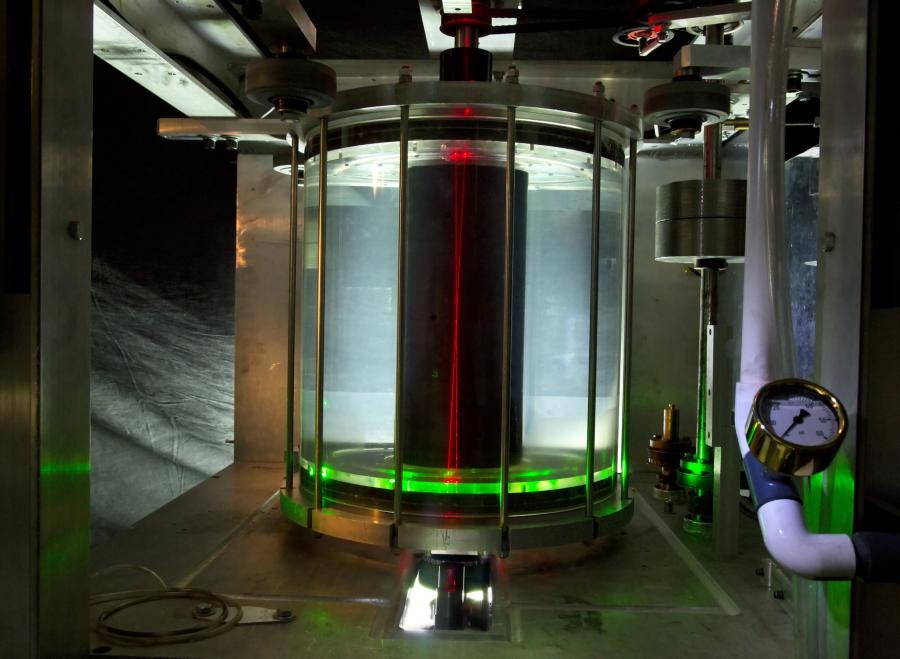Feb 6 2019
How did planets and stars evolve from the clouds of gas and dust that used to fill the cosmos earlier?
 Water-filled version of MRI experiment showing transparent outer cylinder and blackened inner cylinder. Red lasers enter at bottom to measure the local speed of the water. (Image credit: Eric Edlund and Elle Starkman)
Water-filled version of MRI experiment showing transparent outer cylinder and blackened inner cylinder. Red lasers enter at bottom to measure the local speed of the water. (Image credit: Eric Edlund and Elle Starkman)
An innovative experiment performed at the U.S. Department of Energy’s (DOE) Princeton Plasma Physics Laboratory (PPPL) has shown the validity of a well-known theory called “magnetorotational instability,” or MRI, that seeks to give an explanation for the evolution of heavenly bodies.
According to the theory, MRI enables accretion disks, which are clouds of gas, dust, and plasma swirling around growing planets and stars as well as black holes, to collapse into them. The theory explains that this collapse occurs when turbulent swirling plasma, technically called “Keplerian flows,” slowly turns unstable inside a disk. The instability leads to a decrease in angular momentum—the process that preserves orbiting planets from being drawn into the sun—in inner sections of the disk, which subsequently fall into celestial bodies.
In contrast to orbiting planets, the matter in crowded and dense accretion disks may be subject to forces like friction that make the disks to lose angular momentum and be drawn into the objects around which they swirl. Yet, such forces cannot completely account for how quickly matter must fall into larger objects for the formation of stars and planets to occur on a reasonable timescale.
MRI Experiment
Physicists at PPPL have simulated the hypothesized broader process in the MRI experiment conducted at the laboratory. The specialized device includes two concentric cylinders that rotate at distinct speeds. As part of this experiment, the cylinders were filled with water by the researchers and a water-filled plastic ball tethered by a spring was attached to a post at the center of the device; the bending and stretching spring simulated the magnetic forces in the plasma inside the accretion disks. Subsequently, the cylinders were rotated by the researchers who videoed the ball’s behavior as seen from the top down.
The outcomes of the study, published in Communications Physics, compared the motions of the spring-tethered ball upon rotating at different speeds. “With no stretching, nothing happens to the angular momentum,” stated Hantao Ji, a professor of astrophysical sciences at Princeton University and principal researcher on the MRI and a coauthor of the paper. “Nothing also happens if the spring is too strong.”
But direct measurement of the results demonstrated that in the case of weak spring-tethering—similar to the condition of the magnetic fields within accretion disks—the behavior of the ball’s angular momentum was consistent with MRI predictions of developments in a real accretion disk. The outcomes of the study revealed that during the experiment, the weakly tethered rotating ball shifted outward upon gaining angular momentum. As a rotating body’s angular momentum must be conserved, it is necessary for any gains in momentum to be matched by a loss of momentum in the inner section, thereby enabling gravity to draw the disk into the object around which it was orbiting.
Contributors of this research paper include lead author Derek Hung, a former Princeton graduate student, along with physicists Erik Gilson and Kyle Caspary of PPPL and astrophysicist Eric Blackman of the Laboratory for Laser Energetics at the University of Rochester, who came up with the concept. This study was supported by NASA, the National Science Foundation, the DOE Office of Science, the Simons Foundation, the Institute for Advanced Study, and the Kavli Institute for Theoretical Physics.